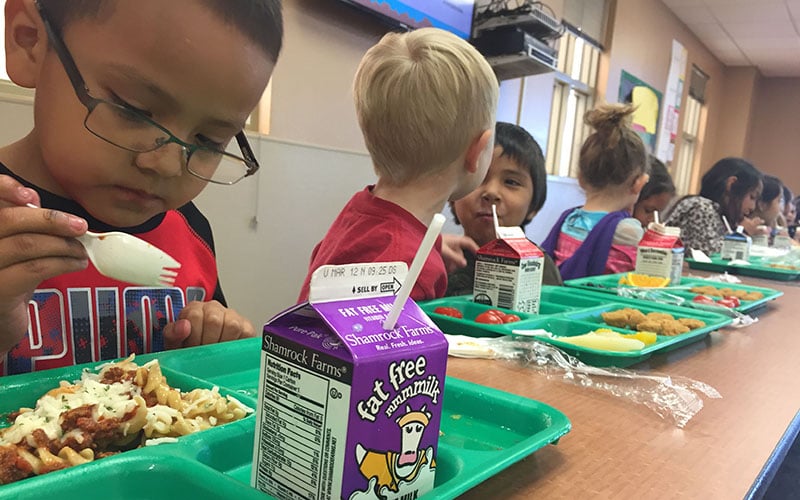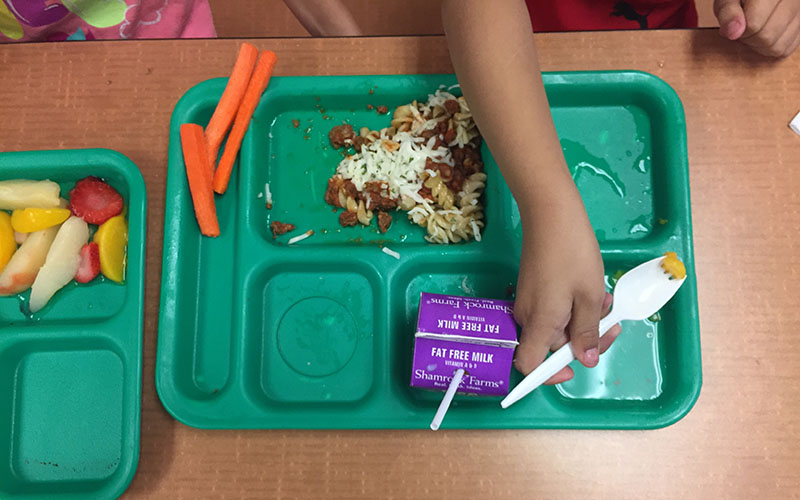
Students at Barbara Robey Elementary School District in Litchfield eating during their lunch hour. Litchfield offers full salad and fruit bars. (Photo by Lily Altavena/Cronkite News)

What’s served for lunch at Barbara Robey Elementary School in Litchfield varies, but students are always encouraged to keep their plates colorful, with fruits and vegetables. (Photo by Lily Altavena/Cronkite News)

Chicken nuggets are a staple in school lunches across the Valley. Students at Barbara Robey Elementary School also have a choice of peanut butter and jelly every day. (Photo by Lily Altavena/Cronkite News)
With proposed U.S. Department of Agriculture cuts in the billions of dollars, the National School Lunch Program – a fundamental part of Arizona’s school day – is facing new uncertainty.
President Donald Trump has proposed slashing $4.7 billion from the USDA, the agency charged with the National School Lunch Program. It’s unclear how the loss of billions of dollars would trickle down to the nation’s styrofoam lunch trays.
The National School Lunch Program is an entitlement program, which means the funds are guaranteed to be authorized without congressional approval and are not in jeopardy. However, programs including the 21st Century Community Learning Programs could lose funding, according to Crystal FitzSimons, the director of school and out-of-school programs at the Food Research and Action Center.
“Those classes really provide the basis for the afterschool meal program,” she said. “If you zeroed out for the 21st Century Community Learning Program, the unintended consequence would be a lot of kids would lose access to afterschool meals.”
And during the school day, poor children would rely even more on their school lunches.
Maricopa County districts took in $209.3 million in federal funding for food service programs in 2016 alone, according to a Cronkite News analysis of district finances. The districts served 198.2 million reimbursable meals and snacks last year. A reimbursable meal, which includes breakfast and lunch, is eligible for federal funding and must follow nutritional guidelines that were last tightened by lawmakers in 2010.
Reporters examined some of the key issues for families and districts in Maricopa County: from the nutrition of bean and cheese burritos to a food service director not afraid of donning a blueberry costume.
1. The Maricopa County families who rely on school lunch programs
For the Wiltbank family, packing a lunch every morning for the six of their children who are in school is almost an impossible task. But paying for a full price lunch for all of the children adds up quickly every week.

Six of the children in the Wiltbank family, including Brytnie (pictured here with her mother, April), are able to pay $0.40 a day for lunch at school because their family qualifies for reduced lunch pricing. (Photo by Sophia Kunthara/Cronkite News)
The family, which has 10 children, qualifies for reduced price lunches in the Queen Creek Unified School District. Through the program, the children are able to receive lunch for $0.40 per day.
“You’re getting enough food to last you through the rest of the day and especially at the price we pay for it, it’s just nice because my parents again, we have so many siblings and so many people in our house, that it costs a lot of money to try to provide for that many people,” said 11th grader Brytnie Wiltbank. “And it’s a lot of work too.”
In the Queen Creek Unified School District where Wiltbank attends school, three out of 10 children qualify for free or reduced lunch. It’s considered a “higher income” school district in the state, because of the high percentage of students who pay the full price for a meal.
But for the students who do qualify and many others who barely miss the threshold, school lunches are a necessity.
Carol Weekly, the director of child nutrition at the Queen Creek Unified School District, said critics of school lunches oftentimes overlook families in higher-income school districts that narrowly miss the qualification for free and reduced lunch.
“Just because you don’t qualify, doesn’t mean that you’re not struggling,” Weekly said. “Doesn’t mean that you still are having a hard time paying the electric bill or buying food. You know, you have working poor. So they don’t qualify for programs but that doesn’t mean that it’s a privilege.”
The Wiltbank family relies on one income after Brytnie’s mother, April Wiltbank, fell sick at the end of 2015 and went on physical disability. And if they had to pay the full price for each child every day, it would take a ‘significant part’ of their monthly budget, she said.
“It’d be really difficult, I can’t physically work,” April Wiltbank said. “But if my husband had to go pick up a second job somewhere, or do something, I mean, we would do what we had to do to make it work, but you know, it would take my husband out of the home even more.”
April Wiltbank had enrolled her children in charter schools before, where lunch for each child every day was $3. With the reduced lunch program, Wiltbank pays $120 a month for all six of her children to eat lunch at school, a third of the price the family paid for all of the children to eat at their charter school.
Brytnie recalled pleading with her parents when she was younger to pack a lunch every day because she felt singled out buying lunch.
“Kids play it off that school lunches are really not a good thing and they play it off like, “Oh you buy school lunch you must not be able to afford to bring your own lunch.’ It makes you feel singled out,” she said. “But I think especially after going to high school, so many kids buy high school lunches now… they’re healthy, they’re good.”
The concept of “lunch shaming” came into the spotlight after a Paradise Valley student was stamped on the hand by a food service worker when he couldn’t pay for lunch. States such as New Mexico have passed laws that ban the practice, which some argue unfairly target lower income students.
At Queen Creek High School, Brytnie said there isn’t a way for students to tell which students are buying their lunch at a reduced price.
“I think a lot of time, lawmakers forget we’re trying to stretch our dollar as best we can,” Wiltbank said.
2. Federal money flows into Valley school districts
School districts in Maricopa County with higher percentages of students receiving free and reduced lunch depend on higher percentages of federal money, according to an analysis of food service annual financial report for districts from 2016.
Eight Maricopa County districts spent less than their allotment of federal funding: those districts were made up of 75 percent or more free and reduced lunch students and were all more than 90 percent minority.
The Cartwright School District is one of those: it spent nearly $12.2 million last year, with more than $13.8 million in federal funding. At Cartwright, every student is served free breakfast and lunch. The surplus helps pay for indirect costs like equipment and electricity, according to Diane Gruman, Cartwright’s food service director.
“There’s very strict regulations on what we can purchase and what we cannot purchase and what we do with our money,” she said.
3. How districts in low-income areas stretch a dollar
For lower-income school districts, it’s in their best interest to serve nutritious meals to receive reimbursement from the federal government.
In the Cartwright Elementary District, 86 percent of students qualify for free and reduced lunches. Because it’s considered a high-needs district, every student is able to eat meals for free. According to the district’s food services director, Diane Gruman, the district is reimbursed about $3 per meal from the federal government.
“It’s a business where we’re only paid if we serve a meal. That’s the only way we get money,” Gruman said. “So, you always want to feed as many kids as we possibly can… it’s all about the participation. The more kids you can feed, the more money you get, and as you feed more students, your labor costs come down.”
Gruman, who previously worked at a more affluent Peoria school district, said higher income school districts often struggle with having students participate in the school lunch program and being reimbursed. More students are able to afford to bring their lunch or go off campus for meals.
“Here it’s great because we feed everybody and we get a reimbursement for everybody and that allows us to be able to do so many more things with the money that more affluent districts struggle with,” Gruman said.
The money that is reimbursed by the federal government has to be used by the department that handles food services, or the state can stop paying future claims, Gruman said. The department is essentially self-functioning, paying for its own food, labor, supplies and maintenance. Funds can be used to purchase equipment for the department or for other maintenance costs, but there are regulations about what can and cannot be purchased by the department.
In addition to the $3 reimbursement, the district receives a commodity reimbursement based on the number of meals served in the previous school meal. That money can be used to purchase items like raw chicken or fresh fruits and vegetables to be served as is or processed into foods.
4. Charter school food services vary wildly
Nearly 30 percent of public schools in Arizona are charter schools, but an unknown fraction offer food service.
“They don’t have to provide those services,” said Jim Hall, the founder of Arizonans for Charter School Accountability, an organization he runs that crunches state data on the schools.
Hall points out that schools are not required to apply for money for food service programs, arguing that this may leave low-income students who depend on these programs out of the equation. Some schools, however, do offer food service programs and comply with federal requirements.
But charter schools don’t necessarily follow public district patterns when it comes to food service to be more adaptable to different kinds of students, like those that attend school at night, according to Eileen Sigmund, the president and CEO of the Arizona Charter Schools Association.
“Our schools are agile and they do want money in the classroom,” she said. “They may not take on the administrative burden of providing a federally mandated program.”
5. The ubiquitous bean and cheese burrito and how it meets nutritional requirements
Though school lunches often come under fire for looking unappetizing or lacking nutrition, one dietician said the value of the meals is more than meets the eye.
Jessie Gruner, a registered dietitian, said school menus often don’t show the whole picture when it comes to the nutritional value of meals. A menu might show only entrees, she said, though there’s also a full salad bar available for students. And foods like dinner rolls, for example, have strict requirements for ingredients used.
With the passage of the 2010 Healthy Hunger-Free Kids Act, schools were required to comply with more regulations for school meals. Food served in schools now have stricter grain, protein and sodium requirement, along with calorie requirements. But Gruner said schools often struggle with complying with these stricter requirements with limited resources and space, which is why many turn to heat-up meals that meet the requirements instead of scratch cooking.
“In terms of making sure they’re performing adequately, number one priority is making sure they’re fed,” Gruner said. “A hungry kid is going to have a hard time learning in the classroom. So that’s always a priority in schools.”
Additionally, schools have to find the happy medium of serving meals that are nutritious and appetizing for children.
“We have to remember these are kiddos,” Gruner said. “So, it’s finding that really fine balance between are we providing really good food for our kids…making sure they’re nourished, and also giving them food that they want to eat. Because kids like pizza, kids like mac and cheese, so I think that’s always a challenge we’re going to have.”
6. How much is spent on actual food? It varies by district.
On annual food service reports, spending on actual food products is split into two main categories: USDA commodities or “other food.” The commodities are food products provided by the USDA often at a dramatically discounted price, while other food is typically not from the government.
“I think commodities have had a tarnished image in the past,” David Schwake, the food service director at the Litchfield Elementary School District, said. “I think a lot of folks don’t realize that the products and the foods that are offered to USDA schools are the same products you can buy in your grocery store shelves.”
A Cronkite News analysis shows the percentage of food service expenditures that went to actual food in Maricopa County school districts. A lower percentage could be for a range of reasons: schools may use gardens to supplement food or could have had higher staff or equipment for costs that year. It may also indicate a food service director particularly adept at stretching their district’s food service budget.
To see all school district food spending, click here.
7. Why breakfast matters to thousands of Maricopa County kids
According to a February 2017 report by the Food Research and Action Center, more than 267,000 children who came from low-income families in Arizona received free breakfast at school during the 2015-2016 school year, 2.8 percent more than in the previous year.
Angie Rodgers, president and CEO of the Association of Arizona Food Banks, said 86 percent of the children in the schools the organization works with receive free and reduced lunch, along with breakfast.
“We try to encourage schools to offer a school breakfast program,” Rodgers said. “And then the second thing we do is make sure that low-income students have as much access to nutrition as every other student. We are trying to encourage schools to adopt a special policy where if they know they have a large number of free and reduced lunch children, participating in the lunch program, that they go ahead and apply their entire school to receive free meals. So you’re not singling out children and recognizing that they’re getting a free meal versus other students.”
At about half of the schools in the Cartwright Elementary School District, every student is able to eat breakfast, lunch and dinner for free because the high percentage of low income families. Diane Gruman, director of food services for the district, said the district’s breakfast program is designed to ensure all students receive a meal during the school day.
“We feed the breakfast in the classroom so the students don’t have to come to school early, they don’t have to worry about the bus being late or the parents not waking them up,” Gruman said.
Rodgers said about 650,000 children in the state are participating in free and reduced lunch programs, and Arizona ranked 29th on the FRAC’s School Breakfast Scorecard.
“Do I think we can do better? Absolutely,” Rodgers said. “I think that the more kids that get nutritious meals at school… we know leads to lower absenteeism, it leads to lower visits to the school nurses, it leads to higher testing scores, obviously well-fed kids are well-educated kids.”
(Video by Natalie Tarangioli/Cronkite News)
8. Meet David Schwake, Litchfield food service director
David Schwake is one of five school nutrition professionals nationally recognized by the School Nutrition Foundation in 2017 as a “school nutrition hero” for his work at the Litchfield Elementary School District.
In the video below, watch Schwake on the job:
(Video by Lily Altavena/Cronkite News)